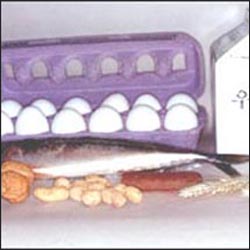아나필락시스(아나필락시/아나필락시스 반응/초과민 반응), Anaphylaxis(Anaphylactic reactions)
아나필락시스(과민증)의 개요
- 미국에서 음식물 알레르기와 음식물 알레르기 아나필락시스 발병률이 영아들과 소아들에게 증가하고 있다. 5.9백만 명의 미 소아들에게 음식물 알레르기가 있고그 음식물 알레르기의 일부는 어린 아이들에게 음식물 알레르기 아나필락시스로 이르게 된다 소스: AAp News 6/2018.
- IgE 항체와 항원의 이상 작용으로 여러 종류의 증상 징후를 나타내는 급성 전신 알레르기성 반응을 아나필락시스, 아나필락시스, 아나필렉스, 또는 과민증이라고 한다.
- 아나필락시스는 제 1형 과민반응에 속한다.
- 아나필락시스의 증상 징후가 경도, 중등도, 중증도로 피부계, 호흡기계 심장혈관기계 등에 나타날 수 있다. 심한 중증도 아나필락시스로 사망할 수 있다.
- 아나필락시스가 IgE 항체 중개 작용으로 생길 수도 있다. 이런 IgE 항체 중개 작용이 없이 비슷한 과민반응이 생길 수 있다. 이런 아나필락시스를 아나릴락시스양 과민반응(Anaphylactoid) 또는 비 면역성 아나필락시스라고 한다.
- 아나필락시스양 과민반응이나 IgE 항체와 항원의 이상 작용으로 생기는 전신 급성 아나필락시스를 즉시 적절히 응급으로 치료받지 않으면 생명을 잃을 위험성도 있고 수분 내 사망하기도 한다.
- 아나필락시스 병력을 가진 환아가 있는 직장에서 일하는 사람들과 그 환아를 치료하는 의료인들은 물론 환아의 부모 또는 그 외 다른 사람들도 아나필락시스에 관해서 잘 알아둘 필요가 있고 필요할 때 응급으로 처치하는 법도 알아 두어야 한다.
- 신체가 어떤 특이 항원에 노출될 때 체내에 그 항원으로 특정 항체가 체내에 생길 수 있다. 아나필락시스는 신체 내 호염기 세포(Basophilics)와 비만세포(Mast cells)에서 대량의 매개체가 유리되어 생길 수 있다.
- 다음 3가지 기전으로 아나필락시스가 생길 수 있다
- 전에 특이 항원으로 생긴 IgE 항체 중개 작용으로 아나필락시스가 생길 수 있다.
- 보체계 활성화 또는 신체 내 호염기 백혈구세포와 비만세포를 직접 자극될 때 아나필락시스가 생길 수 있다.
- 위에서 설명한 바와 같이, 비 IgE 중개 작용으로 아나필락시스가 생길 수 있다.
- 아나릴락시스는 다음 여러 가지에 의해서 생길 수 있다.
- 음식물-땅콩, 우유, 밀가루 음식물, 달걀, 콩, 생선 등
- 곤충 교상-벌 쏘임,
- 약물-페니실린 또는 백신 등
- 라텍스(Latex/레이텍스)
- 방사능 조형물질
- 그 외 다른 여러 종류
- 이때 신체의 여러 계통의 여러 기관과 조직에 급성 알레르기 반응이 생긴다.
- 아나필락시스양 과민반응(비 면역성 아나필락시스)은 IgE 항체와 항원의 이상반응으로 생기지는 않지만 호염기 세포(호염기구)와 비만 세포에서 분비되는 히스타민 등 매개체로 인해 생긴다고 전술했다. 전형적인 예는, X선 검사를 할 때 쓰는 방사능 조형물질로 생기는 아나필락시스가 이에 속한다.
- 연구에 의하면 미국에서는 연간 수백 만 명이 아나필락시스를 경험한다. 아나필락시스로 인해 많은 사람들이 사망 한다.
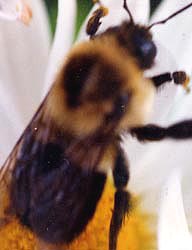
사진 427. 벌에 쏘이거나 곤충교상, 또는 약물, 백신 등으로 아나필락시스가 생길 수 있다.
Copyright ⓒ 2011 John Sangwon Lee, MD, FAAP
사진 428. 땅콩, 우유, 달걀, 생선 등의 음식물에 들은 단백질로 인해 아나필락시스가 생길 수 있다.
Copyright ⓒ 2011 John Sangwon Lee, MD., FAAP
- 땅콩이나 새우 등 음식물로 인해 아나필락시스가 생길 수 있다([부모도 반의사가 되어야 한다-소아가정간호백과]-제15권 소아청소년 알레르기 및 면역질환-음식물 알레르기와 음식물 과민증).
아나필락시스를 일으킬 수 있는 음식물, 약물, 곤충 쏘임, 그 외 항원
- 음식물-수 백종의 음식물이 아나필락시스의 원인이 될 수 있다. 달걀, 생선, 우유, 땅콩, 어패류(조개, 계, 랖스터, 굴, 새우) 메주콩, 나무 견과류(알몬드, 부라질 너트, 캐셔, 피칸, 호두, 필베르트), 딸기, 참깨 등이 아나필락시스의 원인이 될 수 있다. 그 중 달걀, 우유, 메주콩 등으로 아나필락시스가 가장 잘 유발 될 수 있다.
- 달걀, 우유, 메주콩으로 생기는 아나필락시스는 생후 5년 이내에 자연적으로 없어질 수도 있다.
- 5세 이후 아이들이나 성인의 아나필락시스는 땅콩, 나무 견과류, 생선, 패류 등으로 더 잘 생길 수 있다.
- 한 가지 음식물에 아나필락시스가 있는 사람은 다른 음식물에도 아나필락시스가 생길 수 있다.
- 면역치료나 알레르기 피부 반응검사에 쓰는 항원물질, 효소, 치료용 혈청
- 숫하게 많은 종류의 약물 백신 진단용 약물이 아나필락시스를 일으킬 수 있다. 그 중 페니실린, 아스피린, 살맄실산 염(Salicylates),국소 마취제, 코데인, 인슐린, 부신피질 호르몬 , 아편, 국소 마취제 등으로 아나필락시스가 갱길 수 있다.
- 벌에 쏘이거나 곤충교상
- 감마 글로불린이나 예방접종 백신
- 집안 먼지 진드기
- 동물의 비듬
- 꽃가루
- 이상 열거한 항원을 호흡기계를 통해 흡인되거나 주사로 맞거나 경구로 섭취하거나, 또는 피부 층에 접촉될 때 아나필락시스가 생길 수 있다.
- 2005년 캐나다에서 땅콩을 먹은 여성과 키스를 했던 한 남성이 땅콩 단백으로 아나필락시스이 생겨 죽었다는 기사도 있었다.
- 그 외
아나필락시스의 증상 징후
- 아나필락시스의 증상 징후는 땅콩 등 항원에 노출된 후 불과 몇 초 내지 몇 분 내에 나타날 수도 있고 때로는 몇 시간 내 나타날 수 있다.
- 아나필락시스의 증상 징후를 경도, 중등도, 중증으로 분류할 수 있다.
- 중등도 아나필락시스나 중증 아나필락시스가 생기면
- 상기도가 수축되어 기도가 막히고
- 기관지 경련이 생기고,
- 기관지가 좁아지고 ,
- 후두 부종,
- 호흡곤란,
- 신체 각 계통의 기관과 조직의 부종 등
- 빈혈, 부정맥, 순환기 허탈, 저혈압, 쇼크
- 적절히 곧 치료하지 않으면 사망할 수 있다.
- 초기 증상 징후는 정신 불안, 호흡곤란이 생길 수 있다.
- 심하면 혈압이 심하게 강하되고 가슴이 아플 수 있고 기절 할 수 있다.
- 두드러기는 나지 않고 가려운 증상만 생길 수도 있다.
- 아나필락시스의 증상 징후가 호흡기계에 나타나지 않고 바로 쇼크에 빠질 수 있다.
- 두드러기가 전신에 날 수 있고 피부 소양감이 생기고 홍반이 날 수 있다.
- 구기, 구토, 복통, 설사 등의 소화기계통의 증상 징후도 생길 수 있다.
- 콧물, 재채기, 호흡곤란, 심장박동 증가, 빈호흡증, 청색증, 호흡부전증, 천명과 후두 협착음이 생길 수 있다.
- 이런 여러 증상 징후가 나타나면서 환아 자신이 금방 죽을 것 같이 보일 수 있다.
- 급성 증상 징후가 나타나고 조금 뒤에, 두드러기, 목쉼, 안면 부종, 기도 수축 등의 증상 징후가 생길 수도 있다.
아나필락시스의 진단
- 대부분의 경우, 병력, 증상 징후, 진찰소견 등을 종합해서 비교적 진단한다.
- 아나필락시스로 두드러기, 홍조, 가려움증 등 피부계의 증상 징후가 나타나지 않고 호흡계의 증상 징후만 나타나면 오진할 수도 있다.
- 특히 아토피성 체질이거나 알레르기 질환의 병력, 음식물 알레르기, 전에 아나필락시스를 경험한 과거 병력이 있는 아이에게 위에서 설명한 증상 징후가 있을 때는 아나필락시스를진단하기 쉽다.
- 곤충에 쏘이거나 물린 병력, 약물을 먹거나 흡입하거나 주사로 맞은 병력 등은 진단하는 대 도움이 될 수 있다.
- 혈중 마스트세포 중개 히스타민이나 트맆타제 농도를 측정 해 진단에 도움을 받을 수 있다.
아나필락시스의 감별 진단
- 주로 호흡기 증상 징후가 있을 때는 급성 기관지 천식, 크룹(Croup), 기도 내 이물질 흡입 등과 감별진단 해야 한다.
- 박테리아 패혈증으로 인한 쇼크, 기절, 전신 경련 등과 감별 진단해야 한다.
- 소화관 병에 증상 징후가 주로 나타날 때는 음식물 중독, 바이러스 위장염, 위장관 잠혈
- 두드러기나 혈관 부종이 있을 때는 그 외 병 등과 감별진단 해야 한다.
아나필락시스의 치료
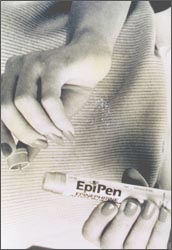
사진 429. 에피펜 자가 주사기나 에피네프린 주사로 응급 치료를 한다.
Used with permission –
- 아나필락시스가 유발되어 사망 할 수 있기 때문에 1초를 다투어 응급으로 치료해야 한다.
- 호흡기계와 심장 혈관계에 아무 증상 징후가 생기지 않는 경도 아나필락시스는 에피네프린제 주사로 치료할 수 있다.
- 에피네프린제가 든 에피펜 (Epipen), 아나키트(Ana-kit) 등 아나필락시스 응급치료용 자가 주사기 약이 없으면 단골 소아청소년과 의사나 응급실에 응급으로 전화 해 그들의 지시에 따라 아나필락시스가 생긴 현장에서 즉시 치료를 시작한다.
- 필요에 따라 기본 심폐 소생술을 시작한다.
- 병원에서는, 생명을 위협할 정도로 위중한 중등도 아나필락시스나 중증 아나필락시스는 에피네프린제 주사를 즉시 주사 하고 필료에 따라 산소호흡치료, 기도 삽입관 호흡치료, 항히스타민제 주사, 코르티코 스테로이드제 주사, 아민노필린제 주사, 혈압 상승제, 전해질 재수화 치료용 용액 정맥주사 등으로 응급 치료를 즉시 시작 하고 아나필락시스의 중증도에 따라 중환자실 입원 치료를 하는 것이 보통이다.
- 필요에 따라 전문 심폐 소생술을 한다.
- 아나필락시스 응급치료용으로 쓰는 에피펜(EpiPen)자가 주사기 약 속에 에피네프린 성분이 들어 있다. 에피펜(EpiPen)자가 주사기 약은 EpiPen 2-Pak과 EpiPen Jr 2-Pak 두 종류가 있고 포장도 조금 다르다. 요즘에는 에피펜 자가 주사기 주사 주는 방법을 말로 설명하는 에피펜도 있다.
- 이 두 종류의 EpiPen 자가 주사기 약 중 하나를 의사의 처방에 따라 집, 학교, 운동장, 차내, 캠프장 등에 보관했다가 필요할 때 쓸 수 있게 해야 한다.
- 두 종류의 EpiPen 자가 주사기 약에 든 Epinephrine의 용량은 다르다.
- 필요한 경우 평소에, 의사로부터 EpiPen 자가 주사기 약 처방을 받아 지참하고 있다가 그의 지시에 따라 응급할 때 본인이나 주위 사람이 주사줄 수 있다.
- 이 약으로 응급 치료를 하기 전 평소에 EpiPen 자가 주사기 약 사용법을 의사로부터 배워야 한다. 가능 하면 단골 의사와 긴급 전화 진료 상담하면서 치료 한다.
아나필락시스(반응)의 예방
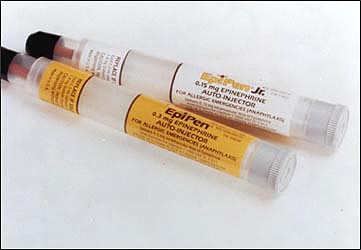
사진 430. 에피펜(EpiPen) 자가 주사기 약을 평소 지참하고 다닌다. 에피펜(EpiPen) 자가 주사기 약은 EpiPen 2-Pak과 EpiPen Jr 2-Pak 두 종류가 있고 포장도 다르다. Used with permission
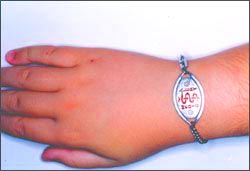
사진 431. 어떤 항원에 아나필락시스가 생겼었다는 과거 병력을 표시한 팔찌 표식을 팔목 에 끼고 다닌다.
Copyright ⓒ 2011 John Sangwon Lee, MD., FAAP
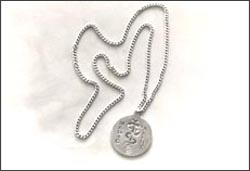
사진 432. 어떤 항원에 아나필락시스가 생겼었다는 과거 병력을 표시한 목걸이를 목에 걸고 다닌다.
Copyright ⓒ 2011 John Sangwon Lee, MD., FAAP
- 벌에 쏘이거나 모기 등 곤충 교상으로 인해 아나필락시스가 생겼던 과거 병력 있는 사람에게 아나필락시스가 다시 유발될 가능성이 있다.
- 아나필락시스의 과거 병력이 있는 아이에게 아나필락시스가 생길 때 그 아나필락시스를 응급으로 치료하기 위해 에피펜 자가 주사기 약이나 아나키트 자가 주사기약을 항시 가지고 다녀야 한다. 그리고 집, 학교 또는 승용차 등 그 아이가 자주 가 있는 장소에도 하나 보관해야한다.
- “어떤 항원으로 인해 아나필락시스가 생겼었다”는 과거 아나필락시스 병력을 표시한 팔복거리 표식이나 목걸이 표식을 달고 다녀야 한다-참조문헌 28
- 음식을 먹을 때는 그 음식물 성분을 꼭 읽어보고 아나필락시스를 일으켰던 음식물 성분이 있으면 그 음식물울 섭취해서는 안된다.
- 벌알레르기 아나필락시스가 생겼으면 향수를 뿌리지 말고 맨발로 걷지 말고 벌이 많이 모이는 곳에 가지 말고 벌이 몸에 앉으면 자연히 날아갈 때 까지 조용히 있고 피크닉에서 음료수를 마시기 전 벌이 음료수 병에 있나 살핀다.
- [부모도 반의사가 되어야 한다-소아가정간호백과]-제15권 소아청소년 알레르기 및 면역질환-아나필락시스(과민반응) 참조
- 미국 각급학교에 에피펜 자가 주사기나 에피네프린 주사 을 법으로 보관하도록 했다(2013년).
Anaphylaxis (Anaphylactic reactions), Anaphylaxis (Anaphylactic reactions)
Overview of Anaphylaxis (Hypersensitivity)
• Food allergy and food allergy anaphylaxis are increasing in infants and children in the United States. 5.9 million American children have food allergies, and some of those food allergies lead to food allergy anaphylaxis in young children Source: AAp News 6/2018.
• Acute systemic allergic reaction showing various symptoms and signs due to the abnormal action of IgE antibodies and antigens is called anaphylaxis, anaphylaxis, anaphylaxis, or hypersensitivity.
• Anaphylaxis is a type 1 hypersensitivity reaction.
• Symptoms of anaphylaxis may be mild, moderate, or severe in the skin system, respiratory system, cardiovascular system, etc.
Severe severity can lead to death from anaphylaxis.
• Anaphylaxis may result from IgE antibody mediated action. In the absence of this IgE antibody-mediated action, similar hypersensitivity reactions may occur. This type of anaphylaxis is called anaphylactoid or non-immune anaphylaxis.
• If systemic acute anaphylaxis caused by an anaphylactic-like hypersensitivity reaction or an abnormal action of IgE antibodies and antigens is not treated promptly and appropriately, there is a risk of death or death within minutes
. • Those who work in the workplace with children with a history of anaphylaxis and the health care workers who treat them, as well as the child’s parents or other people, need to be familiar with anaphylaxis and how to provide first aid when needed.
• When the body is exposed to a specific antigen, a specific antibody may be produced in the body with that antigen. Anaphylaxis can be caused by the release of a large amount of mediators from basophils and mast cells in the body.
• Anaphylaxis can occur through three mechanisms:
1. Anaphylaxis may occur due to the mediated action of IgE antibodies previously generated with specific antigens.
2. Anaphylaxis can occur when complement system activation or direct stimulation of basophil leukocytes and mast cells in the body.
3. As described above, non-IgE-mediated action can lead to anaphylaxis.
• Anaphylaxis can be caused by several things.
o Food – Peanuts, milk, flour foods, eggs, soybeans, fish, etc.
o Insect bite – bee sting,
o Drugs – such as penicillin or vaccines
o Latex
o Radioactive modeling material
o Many other types
• At this time, an acute allergic reaction occurs in various organs and tissues of various systems of the body.
• Anaphylactic-like hypersensitivity reaction (non-immune anaphylaxis) is not caused by an adverse reaction between IgE antibody and antigen, but is caused by mediators such as histamine secreted by basophils (basophils) and mast cells. A typical example is anaphylaxis, which is caused by radioactive modeling materials used in X-ray examination.
• Studies show that millions of people in the United States experience anaphylaxis each year. Many people die from anaphylaxis.

Photo 427. Anaphylaxis can be caused by bee stings, insect bites, drugs, or vaccines. Copyright ⓒ 2011 John Sangwon Lee, MD, FAAP
Picture 428. Protein can cause anaphylaxis in foods such as peanuts, milk, eggs, and fish. Copyright ⓒ 2011 John Sangwon Lee, MD., FAAP
• Foods such as peanuts or shrimp can cause anaphylaxis WWW.DRLEEPEDIATRICS.COM – Volume 15 Children’s Allergy and Immune Disease – Food Allergy and Food Intolerance).
Foods, drugs, insect stings, and other antigens that can cause anaphylaxis
• Food – Hundreds of foods can cause anaphylaxis. Eggs, fish, milk, peanuts, fish and shellfish (shellfish, chicken, lobster, oysters, shrimp) soybeans, tree nuts (almonds, brasil nuts, cashiers, pecans, walnuts, filberts), strawberries, and sesame seeds can cause anaphylaxis. can be Among them, eggs, milk, and soybeans can induce anaphylaxis the most. • Anaphylaxis caused by eggs, milk and soybeans may go away spontaneously within the first 5 years of life.
• After age 5, anaphylaxis in children and adults is more likely to occur with peanuts, tree nuts, fish, and shellfish.
• A person who has anaphylaxis in one food can also develop anaphylaxis in another.
• Antigen substances, enzymes, and therapeutic serum used for immunotherapy or allergic skin reaction test
• Numerous types of drugs Vaccine diagnostic drugs can cause anaphylaxis. Among them, penicillin, aspirin, salicylates, local anesthetics, codeine, insulin, corticosteroids, opiates, and local anesthetics can trigger anaphylaxis.
• Bee stings or insect bites
• Gamma globulin or immunization vaccine
• House dust mites
• Animal dander
• Pollen
• Anaphylaxis may occur when the above-listed antigens are inhaled through the respiratory system, injected, ingested orally, or come into contact with the skin layers. • In 2005, there was an article in Canada that a man who kissed a woman who ate peanuts died of anaphylaxis from peanut protein.
• etc
Symptoms, signs of Anaphylaxis
• Symptoms of anaphylaxis may appear within seconds to minutes or sometimes hours of exposure to an antigen such as peanuts.
• Symptoms of anaphylaxis can be classified as mild, moderate, or severe.
• If you develop moderate or severe anaphylaxis
o Constriction of the upper airway o bronchospasm occurs,
o The bronchi are narrowed,
o laryngeal edema,
o Shortness of breath;
o Edema of organs and tissues of each system of the body, etc. o Anemia, arrhythmia, circulatory collapse, hypotension, shock
o Can cause death if not treated promptly and appropriately.
o Early symptoms Signs may include mental anxiety and shortness of breath. o In severe cases, blood pressure may drop significantly, chest pain, and fainting.
o There may be no hives, only itchy symptoms. o Symptoms of anaphylaxis do not appear
in the respiratory system, and you can go into shock right away.
o Hives may appear all over the body, skin itching, and erythema may occur.
o Symptoms of digestive system such as goji, vomiting, abdominal pain and diarrhea may also occur.
o A runny nose, sneezing, dyspnea, increased heart rate, tachypnea, cyanosis, respiratory failure, wheezing and laryngeal stenosis may occur.
o When these symptoms appear, the child may appear to be about to die soon.
o Shortly after the onset of acute symptomatic signs, symptomatic signs such as hives, hoarseness, facial swelling, and airway constriction may appear.
Diagnosis of Anaphylaxis
• In most cases, a comparative diagnosis is made based on the medical history, symptom signs, and examination findings.
• If anaphylaxis does not show symptoms of the skin system, such as hives, flushing, and itching, but only symptoms of the respiratory system, a misdiagnosis may occur.
• Diagnosis of anaphylaxis is easy, especially when a child with atopic constitution, a history of allergic disease, food allergy, or a previous history of anaphylaxis has the symptoms described above.
• A history of insect stings or bites, and a history of taking, inhaling, or injecting drugs may be helpful in the diagnosis.
• Diagnosis can be aided by measuring the concentration of mast cell-mediated histamine or tryptase in the blood.
Differential diagnosis of anaphylaxis
• When there are mainly respiratory symptoms, differential diagnosis should be made with acute bronchial asthma, croup, and inhalation of foreign substances in the airways.
• Differential diagnosis should be made from shock, fainting, and generalized convulsions due to bacterial sepsis.
• Food poisoning, viral gastroenteritis, and gastrointestinal occult blood
• If there is urticaria or angioedema, it should be differentially diagnosed with other diseases. treatment of anaphylaxis

Picture 429. Give emergency treatment with an epi-pen auto-injector or epinephrine injection. Used with permission –
• Because anaphylaxis can be induced and death can occur, it is necessary to fight for one second and treat it as an emergency.
• Mild anaphylaxis with no symptoms of respiratory or cardiovascular system can be treated with injection of epinephrine.
• If there is no self-injector medication for emergency treatment of anaphylaxis such as Epipen or Ana-kit containing epinephrine, call a regular pediatrician or emergency room and receive immediate treatment at the site of anaphylaxis according to their instructions to start
• Initiate basic CPR as needed.
• In the hospital, for moderate anaphylaxis or severe anaphylaxis that is life-threatening, immediate injection of epinephrine, oxygen breathing therapy, airway intubation breathing therapy, antihistamine injection, corticosteroid injection, aminophylline injection, It is common to start emergency treatment immediately with an intravenous injection of an antihypertensive agent or electrolyte rehydration solution, and to be hospitalized in the intensive care unit according to the severity of anaphylaxis.
• Perform advanced CPR as needed.
• EpiPen self-injector used for emergency treatment of anaphylaxis contains epinephrine. There are two types of EpiPen self-injector drugs, EpiPen 2-Pak and EpiPen Jr 2-Pak, and the packaging is slightly different. These days, there is also an Epi-Pen that verbally explains how to inject an Epi-Pen auto-injector.
• One of these two types of EpiPen self-injecting medication should be stored at home, school, playground, car, campsite, etc., as prescribed by your doctor, and made available when needed.
• The doses of Epinephrine in the two types of EpiPen autoinjectors are different.
• If necessary, you usually get a prescription for an EpiPen self-injector from your doctor and bring it with you, and you or someone around you can inject it in case of an emergency according to his instructions.
• Before giving emergency treatment with this medicine, you should learn from your doctor how to use the EpiPen self-injector on a regular basis. If possible, treat it while consulting with a regular doctor for emergency phone treatment.
Prevention of anaphylaxis (reaction)

Photo 430. EpiPen I usually carry self-injector medication. EpiPen auto-injector drugs are available in two types, EpiPen 2-Pak and EpiPen Jr 2-Pak, with different packaging. Used with permission

Photo 431. A bracelet mark indicating a past history of anaphylaxis to a certain antigen is worn on the wrist. Copyright ⓒ 2011 John Sangwon Lee, MD., FAAP

Photo 432. A necklace indicating a past history of anaphylaxis with a certain antigen is worn around the neck. Copyright ⓒ 2011 John Sangwon Lee, MD., FAAP
• There is a possibility that anaphylaxis may recur in people with a previous history of anaphylaxis from bee stings or insect bites such as mosquitoes.
• When a child with a history of anaphylaxis develops anaphylaxis, the EpiPen auto-injector or Anakit auto-injector should be carried at all times for emergency treatment of the anaphylaxis. And you should keep one at home, school, or in a car where the child frequently visits.
• You must wear a badge or necklace indicating your past history of anaphylaxis, saying “A certain antigen caused anaphylaxis.” – Reference 28
• When eating food, be sure to read the food ingredients, and if there is a food ingredient that caused anaphylaxis, do not eat the food.
• If you have bee allergy anaphylaxis, do not spray perfume, do not walk barefoot, do not go to places where there are a lot of bees, and if bees sit on your body, keep quiet until they fly away. • www./drleeprediatrics.com – Volume 15 Children and Adolescent Allergy and Immune Disorders – Anaphylaxis (hypersensitivity reaction)
• Requires schools in the United States to keep epi-pen self-injectors or epinephrine injections by law (2013).
출처 및 참조 문헌 Sources and references
- NelsonTextbook of Pediatrics 22ND Ed
- The Harriet Lane Handbook 22ND Ed
- Growth and development of the children
- Red Book 32nd Ed 2021-2024
- Neonatal Resuscitation, American Academy Pediatrics
- A SUPPLEMENT TO PEDIATRICS, SYNAPSIS BOOK, BEST ARTICLES RELEVANT TO PEDIATRIC ALLERGY, ASTHMA, IMMUNOLOGY, PEDIATRICS OFFICIAL JOURNAL OF THE AMERICAN ACADEMY.12/2019
- Manual of emergency pediatrics 4th edition, Robert M. Reece, M.D., p.15-16
- Emergency Pediatrics, A guide to ambulatory care, 5th Edi. Roger M. Barkin, Peter Rosen, p.125-128
- Quick Reference to Pediatric Emergencies, Delmer J. Pascoe, M.D., Mose Grossman, M.D., p.11-12
- Emergency care and transportation of the sick and injured, 3rd edition, American Academy of orthopedic surgeons. p.69, 70-71, 249, 328, 332, 333
- Nelson textbook, 14th edition p.601-602
- The Johns Hopkins Hospital, The Harriet Lane Handbook, 18th edition, p.9-10, 389, 391
- Anaphylaxis July 1996 Contemporary pediatrics
- 소아가정간호백과-부모도 반의사가 되어야 한다, 이상원
- Pediatric Asthma, The Pediatric Clinics of North America June 2003
- The Johns Hopkins Hospital, The Harriet Lane Handbook, 22nd edition
- Red book 31st edition 2012
- Nelson Text Book of Pediatrics 21st Edition
- Infectious disease of children, Saul Krugman, Samuel L Katz, Ann A. Gershon, Catherine Wilfert
- 제15권 소아청소년 알레르기․ 자가 면역 질환 참조문헌 및 출처
- Emergency Care Transportation of Sick and Injured American Academy of Orthopaedic Surgeons
- Emergency Pediatrics A Guide to Ambulatory Care, Roger M. Barkin, Peter Rosen
- Allergy Management in clinical practice Louis Tuft
- Food Allergy in Children Pediatric Clinics of North America in April 2011
- 의학 용어사전 대한 의사 협회
- AAP News 6/2018
Copyright ⓒ 2020 John Sangwon Lee, MD., FAAP
“부모도 반의사가 되어야 한다”-내용은 여러분들의 의사로부터 얻은 정보와 진료를 대신할 수 없습니다.
“The information contained in this publication should not be used as a substitute for the medical care and advice of your doctor. There may be variations in treatment that your doctor may recommend based on individual facts and circumstances.
“Parental education is the best medicine.
